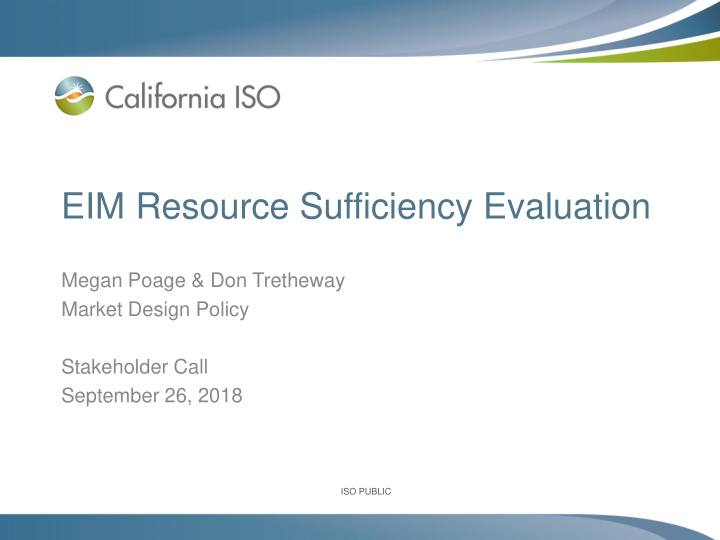



EIM Resource Sufficiency Evaluation Megan Poage & Don Tretheway Market Design Policy Stakeholder Call September 26, 2018 ISO PUBLIC ISO PUBLIC
ISO proposes resource sufficiency evaluation improvements in response to stakeholder comments • EIM Offer Rules workshops held on April 30 and July 19, 2018 – EIM Resource Sufficiency Evaluation – EIM Mitigation and default energy bid options • Some resource sufficiency evaluation improvements can be implemented quickly through the BPM change process • EIM Mitigation is being addressed as a new initiative ISO PUBLIC Page 2
Fifteen-min freeze for flexible ramping test failures can be implemented with BPM changes by end of 2018 • Current test evaluates ramp intervals from last 15-min interval of proceeding operating hour to each 15-min interval of current operating hour – If any of the four ramp tests are failed, EIM transfers are limited • ISO proposes to evaluate each ramp individually – If a ramp test is failed, EIM transfers will be limited to the previous 15-min interval schedule just for the corresponding interval ISO PUBLIC Page 3
Introduction of a 1% tolerance band for the flexible ramping test can be implemented with BPM changes by end of 2018 • Currently EIM entities will fail the flexible ramping test even if requirement is not met by an inconsequential MW value (i.e. 0.5 MW) • ISO proposes a 1% (or 1MW, whichever is greater) tolerance band – If ramping capability for one of the four ramping tests is within the tolerance band, EIM transfers will not be limited • 1% tolerance band aligns with the current balancing test to determine if under/over scheduling penalties apply ISO PUBLIC Page 4
Fifteen-min granularity for balancing and capacity tests will be implemented with the DAME initiative • Balance test will be performed for each fifteen-minute interval and corresponding over/under scheduling penalties will be applied to that 15-min interval • Capacity test will be performed for each fifteen-minute interval and failure will result in limiting EIM transfers to previous fifteen-min interval value • Require tariff changes and will be implemented with DAME Phase1 in the fall of 2020 ISO PUBLIC Page 5
Use of new approach to calculate flexible ramping requirement can be implemented with a BPM change • Stakeholders have suggested the flexible ramping requirement be calculated based on forecasted load, wind and solar • Currently, the ISO uses a histogram to determine the requirement • ISO is investigating alternate approaches to calculate the requirement • Tariff change is not required – Implementation date must be known prior to starting the BPM change process ISO PUBLIC Page 6
CAISO undelivered intertie resources will be addressed in the Intertie Deviation Settlement initiative • Stakeholders have raised concern that the ISO is counting undelivered imports towards the resource sufficiency evaluation • The CAISO has declined to implement bid source verification: – This standard would be greater than other EIM entities – EIM Y1 Phase 2 clarified that E-Tags approval (i.e. E-Tag can be pending) is not needed for submission of base schedules used in the resource sufficiency evaluation • Problem is specific to ISO hourly block resources and is being addressed in the IDS initiative • RA Enhancements initiative will address delivery of resource adequacy on the interties ISO PUBLIC Page 7
The ISO is providing additional metrics regarding the resource sufficiency evaluation in the MPPF • Per stakeholder request, the ISO has already published data related to the frequency of resource sufficiency evaluation failures for each BAA – See August 29, 2018 MPPF • ISO plans to develop additional metrics that will be published and discussed at the MPPF on December 11, 2018 ISO PUBLIC Page 8
The ISO will not permit use of available balancing capacity (ABC) in the resource sufficiency evaluation • Available balancing capacity (ABC) is intended to resolve infeasibilities for each EIM BAA individually, where as flexible ramping product is used to address uncertainty across the entire EIM footprint • The ISO tariff explicitly states ABC will not count towards the resource sufficiency evaluation – Purpose of ABC was discussed as a part of a FERC proceeding ISO PUBLIC Page 9
Holistic review of the resource sufficiency evaluation will occur in the EDAM initiative • Extending the day-ahead market to the EIM (EDAM) will require a day-ahead resource sufficiency evaluation • A day-ahead resource sufficiency evaluation must align with the real-time evaluation • The EDAM stakeholder process will begin in the middle of 2019 and will include a holistic review of the resource efficiency evaluation to ensure alignment across the day- ahead and real-time markets ISO PUBLIC Page 10
The ISO has appreciated stakeholder engagement to develop these enhancements • Fifteen-minute freeze and tolerance band for flexible ramping test will be implemented by the end of 2018 • Additional improvements will be presented to stakeholder in separate initiatives • Holistic review will occur with the EDAM initiative ISO PUBLIC Page 11
Recommend
More recommend